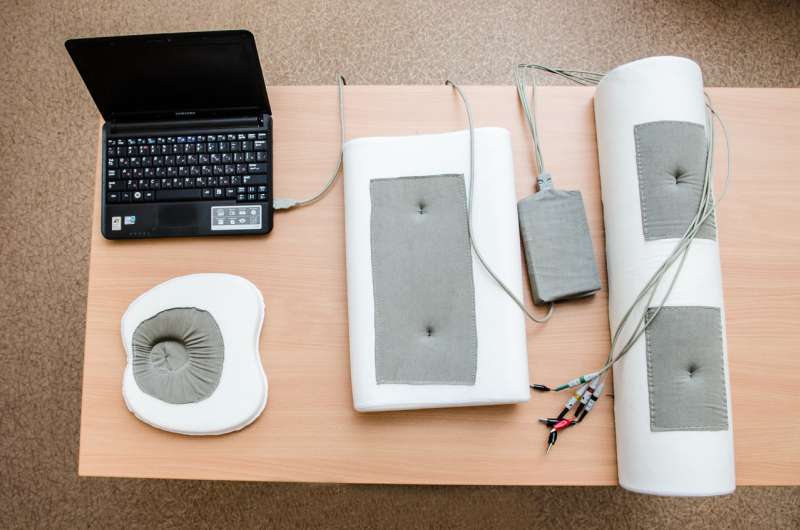A pillow for non-contact heart monitoring suitable even for babies is being designed in south ural

A team of scientists from the SUSU's Institute of Sport, Tourism and Service is developing modern devices for non-contact ECG monitoring in order to improve its efficiency and expand the possibilities of diagnostics. At present, an innovative device is being tested at an intensive therapy unit of one of the Chelyabinsk hospitals which would allow to perform ECG screening of the condition of bed-case patients and disabled people. The final results of testing will be summarized in the end of October.
In modern medicine, early diagnostics and monitoring of the state of both people with various diseases and healthy people is very important. Electrocardiography is quite a simple and efficient method of controlling heart status.
For 3 years now, a team of scientists under supervision of Vladimir Kodkin, Doctor of Engineering Science, Professor at the ISTiS Department of Physical Education and Health, has been working on creating modern devices using a unique technology of non-contact electrocardiogram tracing. One of such devices is an orthopedic pillow with an in-built ECG monitoring system.
"At present orthopedic memory pillows are in very big demand at our hospitals. Most often such pillows are a necessity for patients with limited physical capacity to move around, that is bed-case patients. So, we came up with this idea: what if we could combine a pillow and a system for functional state monitoring?" says Vladimir Kodkin.
A pillowcase of such a pillow is made of special electrically conductive fabric with silver-plated fiber, to which graphene fibers are planned to be added in the future in order to enhance its conductivity. The scientists from South Ural State University are testing this innovation device at the intensive therapy unit of the Regional Children's Hospital. The obtained results already allow us to speak of high efficiency and big potential of such diagnostic devices. "Rosava" Trading Company acts as a partner in this research. Besides the pillow for bed-case patients, a pillow for newborns is also being designed.
"For now it is quite a problem to perform electrocardiogram tracing with a baby as you have to undress it, attach special electrodes to its arms, and since it is constantly moving, it is difficult to do the ECG screening. Our pillow will help resolve these problems because with our device a baby can remain in napkins – the main condition is that its head touches the pillow," explains Vladimir Lvovich.
Vladimir Kodkin developed a special computer program for this research. But since the non-contact method produces a non-standard ECG signal, doctors and physiologists will have to learn to read it.
Another field where the SUSU scientists are using the system of non-contact electrocardiogram tracing is working with athletes. A special T-shirt was created for them made of the same electrically conductive fabric with in-built electrodes. Anastasia Khafizova, a postgraduate at the Department of Physical Education and Health and Director of a small innovative enterprise fulfilling this program, has been actively participating in this scientific work.
"Wearing this T-shirt an athlete will not feel any discomfort which could be associated for instance with using a heart-rate monitor. We performed tests with a stationary bicycle which proved that seeing an electrocardiogram is not a problem at all. You could also calculate heart rhythm and a range of other parameters,"explains Anastasia Khafizova.
As of today, quite a big number of papers on heart rate variability have been published in Chelyabinsk and other Russian cities. But in all of them heart rate variability is assessed without loads. The experiments by the scientists from South Ural State University show that using modern gadgets, such as a non-contact ECG T-shirt, you can monitor how a person works out under load, how his or her heart rate variability changes, you can trace the variability character and see what is happening to body when it relaxes. This allowed the scientists to come up with certain hypotheses of human heart behavior under load.
"After a work-intensive phase athletes normally undergo a recovery period, during which medications are frequently used," elaborates Vladimir Kodkin. "In order to prevent severe recovery process, you may, using our device, monitor the electrocardiogram readings already during the training period. It will allow to timely advise an athlete on when it is better to take a short break, lower load, or at which exact moments the fatigue is the highest. This will help reach the best results in sports, as well as prevent serious health problems."
Today, the heads of the SUSU's Institute of Sport, Tourism and Service are developing various programs on launching non-contact ECG T-shirts into mass use. Also, the scientists are working on wireless communications, what requires implementation of certain technical innovations.
"Surely, analogous developments already exist around the world," admits Vladimir Lvovich. "For instance, there is a similar ECG T-shirt in the USA. However, in the American version only such parameters as heart rhythm and rate are monitored. These readings may be obtained with a common heart-rate monitor. Our device deals with a wider complex of human health status parameters."
For several solutions, for instance one for non-contact ECG, the SUSU scientists have already obtained patents. Now, they have filed a patent application for the non-stop monitoring device and the use of electrically conductive fabrics, and a series of other patent applications is being prepared. Moreover, the scientists are developing a program which will be independently analyzing data and suggesting simple recommendations such as "take a break," "consult a doctor," and others. But to reveal the required data, an experimental data base should be augmented. The joint work planned with the Chelyabinsk Regional Hospital will undoubtedly provide the required data for further research.


















